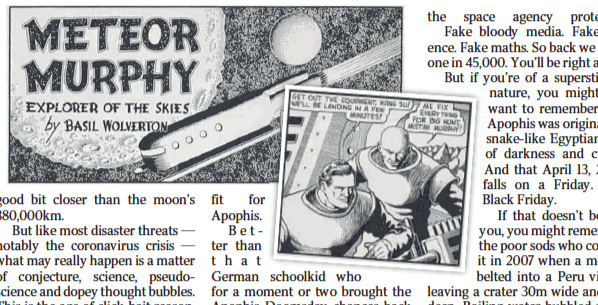
Might be a little regression going on at my place during this lockdown.
Pandemics, things falling out of the sky – viz, 787 Dreamliners carrying deadly bat-fevers. Giant cruise liners, even nuclear-powered aircraft carriers, loaded with invisible biological warfare agents. It’s all sounding like a series of comic-book plots …
Great source of fascination, the old graphic novels, and older the better. And no time better than the pandemic quarantine to trawl through the old collection.
The Golden Age of sci-fi super-heroes saw everyone from heavyweights Flash Gordon, Buck Rogers and John Carter to Silver Starr, Dan Dare and Superman zapping and slugging it out with villains galore and all manner of super-carriers of death and destruction.
Aliens and planetary extinctions were de rigueur, asteroids and meteorite strikes, volcanic eruptions, seismic tremblors too.
You may or may not be familiar with one asteroid headed our way called Apophis, with trouble writ large across its 320-metre wide rocky carcass. It’s one for the diary, 13 April 2029. If we ever get there.
Apophis, also known as asteroid 2004 MN4, is expected to come within about 30,000km of Earth, a good bit closer than the Moon’s 380,000km.
But like most disaster threats – notably the coronavirus crisis – what may really happen is a matter of conjecture, science, pseudo-science and dopey thought bubbles. This is the age of click-bait reason, after all.
At the outset, astronomers thought Apophis was going to hit us. NASA suggested a one-in-60 chance. Then someone rebooted their calculator, pushed the asteroid and the likelihood of Armageddon out to one in 10,000. So we breathe easy again.
But it still sounds like a job for Meteor Murphy to me.
Artist Basil Wolverton’s ‘Explorer of the Skies’, abled assisted by an Asian sidekick called Kang Su, was normally gallivanting across the universe for no better reason than a lust for adventure.
Last I read, he was trying to cool his jets on the planet of peril, Mercury. Parched on one side by the Sun, and frozen solid in darkness on the other, shunned by all except the most adventuresome of space travellers …
Sorry, getting a bit carried away. But I reckon Meteor Murph, no relation by the way, would be a good fit for Apophis.
Better than that German schoolkid who for a moment or two brought the Apophis Doomsday chances back to one in 450 after ‘correcting’ NASA’s figures.
He argued Apophis would likely hit one of the multitude of satellites sweeping around the planet, altering its trajectory and spelling catastrophe next time it visited Earth – in 2036.
That catastrophe, by the way, NASA and the kid agreed would be characterised by a giant 200 billion tonne ball of iron and iridium slamming into the Atlantic. Tsunamis, clouds of dust forever. Who you gonna call?
But NASA’s nose was out of joint. Get your facts right, kid, it said. The asteroid wasn’t going near the main belt of satellites and the chance of collision was exceedingly remote.
Moreover, the paper reporting the kid also reported that NASA had confirmed the kid’s calculations. BS apparently. “Contrary to recent press reports, NASA offices involved in near-earth object research were not contacted,” the space agency protested.
Fake bloody media. Fake science. Fake maths. So back we go to one in 45,000. You’ll be right again.
But if you’re of a superstitious nature, you might just want to remember that Apophis was originally a snake-like Egyptian god of darkness and chaos. And that 13 April 2029 falls on a Friday. Yep. Black Friday.
If that doesn’t bother you, you might remember the poor sods who copped it in 2007 when a meteor belted into a Peru village leaving a crater 30 metres wide and six metres deep.
Boiling water bubbled up in the crater, stinking noxious gases too, and people who got too close came down with a range of not-so-nice symptoms. Vomiting, dizziness, headaches, diarrhoea, nausea, skin complaints.
Was it radiation poisoning? Extra-terrestrial viruses or bacteria? Could have been anything until it was discovered groundwater in the area contained arsenic compounds. Boil the stuff up with a fiery meteorite and surely you’re asking for trouble.
But no, the arsenic levels were actually pretty normal. Vapourised troilite – a sulphurous compound in the meteorite – ended up copping the blame. Pohutu. Like sticking your head in a Kiwi mud-geyser.
That was definitely a job for Meteor Murphy. He’d have figured things out in a nano-second. Pity he was out of publication by then.
Never a decent hero around when you need them.
— This article appeared in the Geelong Advertiser 5 May 2020
Link: https://regionalnews.smedia.com.au/geelongadvertiser/TranslateArticle.aspx?doc=NCGA%2F2020%2F05%2F05&entity=ar01703


